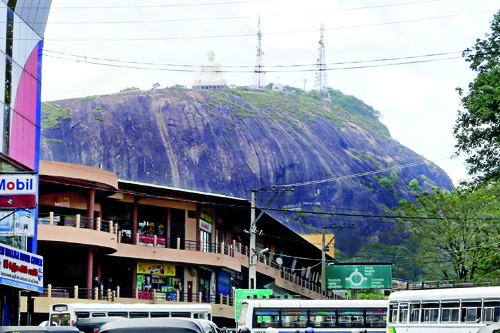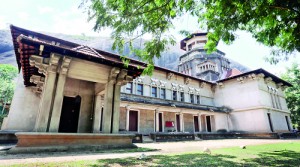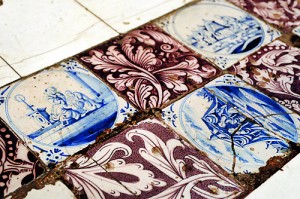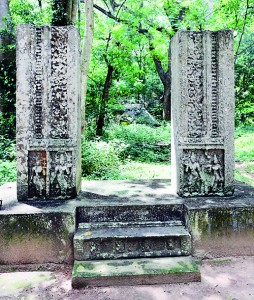Looking down at a kingdom
The large rock is a distinct geographical feature of this town, though today, we may pass through Kurunegala little thinking of the historical significance of this ancient Royal Kingdom. Just 94 km from Colombo, Kurunegala is a fascinating destination, well worth a day’s visit, if a longer stay is not possible.

Kurunegala landmark: Ethagala-the Elephant Rock with the Buddha statue. Pix by M.A. Pushpa Kumara
Known as the Hasthisailapura–its regal name, referred also to as Athugalpura at times, Kurunegala was a one-time Kingdom of Sri Lanka when the monarchy under pressure from foreign invasions changed its citadel from Dambadeniya and Yapahuwa to Kurunegala from its earlier locations in Anuradhapura and Polonnaruwa.
Having set off from Colombo around 5.30 a.m., we reached our destination in a little less than three and half hours as indicated by the majestic clock tower that stands tall in the heart of the Kurunegala town. This clock tower was erected in memory of those who went from the North Western Province to World War I, and it was later dedicated to the soldiers who sacrificed their lives in World War II.
The famous Ethagala, the Elephant Rock, so called because it looks like an elephant, and the colossal Buddha statue atop the rock overlooking the town is a landmark that welcomes the traveller to Kurunegala. Ethagala stands 700 feet high and you can reach the top climbing up a fairly precipitous flight of steps carved on the rock though from Kachcheriya Road, a motorable 1.9 km long road winds through lush greenery providing easy access to the top. The panoramic view of the city and the surroundings– is mesmerising, the serene beauty of the 66 foot tall Buddha image and the slight breeze making this a memorable stop.

Cathedral of the Christ King
The garden compound of the Kurunegala Governor’s office called ‘Maligawa’ is a mini archaeological corner where spouts, astragals, balustrades, stone door frames, stone pillars, guardstones and ruins of the Dalada Maligawa built in Kurunegala by King Prakramabahu the IV are preserved. Interestingly, here you find a wooden craft which was believed to have been used by Royalty during the Kurunegala era. It had, we were told, been excavated from the Kurunegala Lake.
On the Kurunegala – Kandy Road, is the Cathedral of Christ the King, with a huge rock in the backdrop. Built in the 1950s, this is the main Anglican Church of the Kurunegala Diocese. The Cathedral was built by Rt. Rev. Lakdasa de Mel, founder Bishop of the Kurunegala Diocese as the Diocese did not have a Cathedral back then. The nave, roof and the pinnacle of the Church indicates that the structure is an amalgamation of

Dutch tiles at Ridhi Viharaya
Polonnaruwa and Kandy period architecture.
Next we travelled to the Moneragala Rambodagalla Ridigama Temple, 20 km. from the main town, in search of the colossal Rambodagalla granite Samadhi statue said to be rising to great heights. Acclaimed as the world’s largest granite Samadhi Buddha statue, the statue is being carved on a rock boulder by a group of Indian sculptors, with Padma Shri M.M.Sthapathi as the chief sculptor. Work is still in progress. Begun in September 2002, this 67.5 feet tall statue was conceptualised by Ven. Egodamulla Amaramoli Thera following the destruction of the Bamiyan Buddha statue by the Taliban in 2001.
Ridi Viharaya in close proximity to Rambodagalla is a must see. Closely associated with the King Dutugamunu’s task of building Ruwanwelisaya, it is from this location that he had found a large haul of silver that was used to construct the stupa. A temple that dates back to King Dutugamunu’s era, it is believed to have been developed with the influence of Anuradhapura, Polonnaruwa and Kandy periods.
The legend states that a group of merchants, arriving at the jungle close to the location had come across a jak fruit and offered it to a Buddhist monk occupying a cave there. The monk Indraguptha, having consumed the jakfruit, had directed the merchants to a cave with a massive silver ore. It is the silver found from this location that had been used to build the Ruwanweliseya, and as a tribute, the King constructed this temple. The structure where monk Indraguptha had accepted the jak fruit offered by the merchants known as Waraka Weladu Sthanaya (Place where

Remains of a stone door frame at the Governor’s office premises
Waraka was consumed) could be seen at the temple. This stone edifice, ornamented with elaborate carvings, resembles a Polonnaruwa era building.
The Sarasum Gala – a rock where King Dutugamunu dressed himself in Royal attire is found to the right of the temple while atop the Sarasum Gala, you come across rock inscriptions. An intricate carved ivory door frame found at the temple’s cave chamber, a gold Buddha statue which was brought to the temple by the King, marble statutes of Lord Buddha, a statue of King Dutugamunu created outof Chandrakanthi stone provide an insight in to the era.
Inside the temple chamber you find a set of tiles depicting the life of Jesus Christ believed to have been donated by the then Dutch Governor to the monk.
The upper temple chamber rich with paintings that belong to the Kandyan period provides a wealth of knowledge for those with an interest in the art of temple paintings and murals.
Our next stop was at Arankelle –an ancient monastery about 4 km interior from Kurunegala to Madagalla, through Ibbagamuwa along a stretch of lush paddy fields. The monastery is said to have been occupied by 12,000 monks in retreat from time to time during the period 800-1000 AD. A secluded monastery spread across 65 acres of land, back in the day, it had been equipped with all facilities needed for the monks in retreat, including medical care. A stroll around this forest monastery through stone pathways going right round, will afford you a glimpse of the ruins – herbal grinders, hot baths with natural purification methods, stone medicine strainers, sick rooms done out of massive rock slabs, the cave clusters used for meditation, ponds, urinals and a 1800 ft long walkway for monks (Sakman Maluwa) , all of which indicate the great craftsmanship that has gone into creating this marvelous hideaway.
Our final location was the Yapahuwa rock which is built around a huge granite rock. In appearance it somewhat resembles the Sigiriya fortress. Just 30 km from Arankelle along the Madagalla Road, itt was believed that Yapahuwa has served as a military stronghold for King Buwanekabahu I, to evade foreign invaders.
Visitors to the Yapahuwa rock can see many traces of the ancient palace and the fortress built by the King in 1273 – a steep stone stairway and the fortification with moats and ramparts leading to the massive boulder and the famous Yapahuwa lion sculpture as guard stones on either side which is reprinted on our country’s 10 rupee note.
It is said that with the transfer of the kingdom from Dambadeniya to Yapahuwa, King Buwanekabahu brought the Sacred Tooth Relic to this location. Prior to his arrival there, a military leader by the name of Suba had occupied the Yapahuwa rock as his military base to prevent Maga invasions, and the place was therefore referred to as ‘Suba Pabbatha.’
Exploring the attractions of Kurunegala within a day is somewhat of a difficult task.


